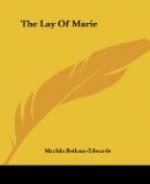not at all to the Romance. 3. She dedicates
her lays to a king who understood English, because
she takes care to translate into that tongue all the
Welsh and Armoric proper names that she was obliged
to introduce. Thus in the Lay of Bisclaveret,
she says, the English translate this name by that of
Garwaf, (Were-wolf); in that of Laustic,
that they call it Nihtgale (Nightingale); and
in that of Chevrefeuille, Gotelef, (Goatleaf)
&c. It is certain, then, she composed for a king
who understood English. 4. She tells us that
she had declined translating Latin histories into
Romance; because so many others having been
thus occupied, her name would have been confounded
with the multitude, and her labours unattended with
honour. Now this circumstance perfectly corresponds
with the reign of Henry III. when such a number of
Normans and Anglo-Normans had, for more than half
a century, translated from the Latin so many romances
of chivalry; and especially those of the Round Table,
which we owe to the Kings of England. 5. Fauchet
and Pasquier inform us, that Mary lived about the
middle of the 13th century, and this would exactly
coincide with the reign of that prince.[10] 6.
Denis Pyramu[11], an Anglo-Norman poet, speaks of Mary
as an author, whose person was as much beloved as
her writings, and who therefore must have lived in
his own time. Now it is known that this poet
wrote under Henry III. and this opinion could only
be confuted by maintaining that it was rather a King
of France of whom she speaks, which king must have
been Louis VIII. or St. Louis his son. But this
alteration will not bear the slightest examination;
for how could it be necessary to explain Welsh and
Armoric words to a French king in the English language?
How could the writer permit herself to make use of
English words, in many parts of her work, which would
most probably be unintelligible to that prince, and
most certainly so to the greatest part of his subjects?
It is true that she sometimes explains them in Romance,
but not always; and when, upon the other hand, she
makes a constant practice of translating them into
English, she proves to what sort of readers she was
principally addressing herself. The list of the
lays of Mary is omitted here, as a translation follows.
The smaller poems of Mary are, in general, of much importance, as to the knowledge of ancient chivalry. Their author has described manners with a pencil at once faithful and pleasing. She arrests the attention of her readers by the subjects of her stories, by the interest which she skilfully blends in them, and by the simple and natural language in which she relates them. In spite of her rapid and flowing style, nothing is forgotten in her details—nothing escapes her in her descriptions. With what grace has she depicted the charming deliverer of the unhappy Lanval! Her beauty is equally impressive, engaging, and seductive; an immense crowd follows but to admire




